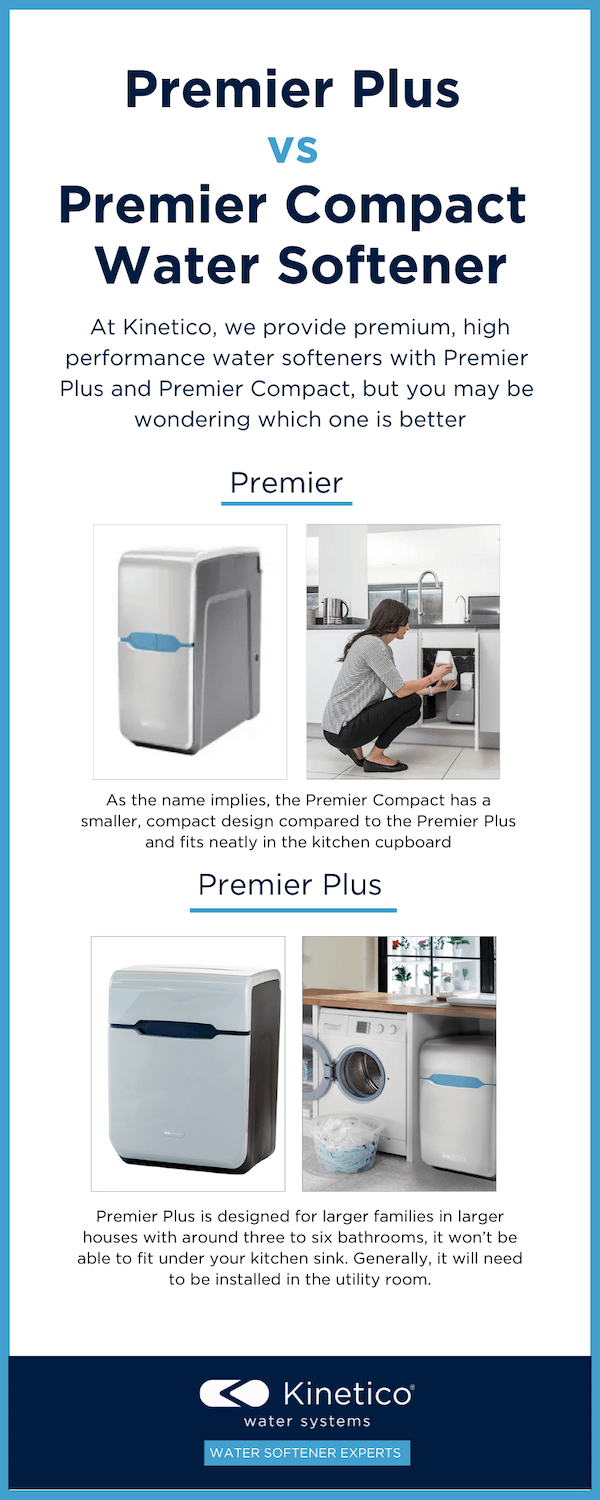If you’ve ever found yourself thinking “what water softener is right for me?” don’t worry! We’ve come up with a guide on what to look out for.
Premier Plus vs Premier Compact Water Softener
At Kinetico, we provide premium, high performance water softeners with Premier Plus and Premier Compact, but you may be wondering which one is better. Both systems share the same advantages, including:
- Using non-electric means for power.
- Exceptional flow rates.
- 10 year warranty.
- Twin-tank system.
- Economical and low salt consumption.
We’ll go further into why twin-tanks and non-electric water softeners are ideal below, but first, let’s go over what makes these products different so you can decide which is best for your home.
As the Premier Plus water softener is designed for larger families in larger houses with around three to six bathrooms, it won’t be able to fit under your kitchen sink. Generally, it will need to be installed in the utility room.
Alternatively, if you’re looking for a product that’s suitable for a snug fit, the Premier Compact water softener is ideal. As the name implies, the Premier Compact has a smaller, compact design compared to the Premier Plus and fits neatly in the kitchen cupboard. This water softener is suitable for houses with up to three bathrooms.

Single-Tank vs Twin-Tank Water Softener
Single-tank water softeners contain — you guessed it — one tank! Do I need to tell you what the twin ones contain? That’s right, two tanks! We don’t stock single-tank water softeners, but we’ll explain the difference anyway.
These tanks are filled with food-grade resin, and this is what we need to treat hard water. Both types of units have a metering device to measure the amount of water used. However, there’s an important reason why you should opt for twin-tank systems over single.
Once the single-tank has reached its capacity, it needs to clean itself, and this is called the regeneration process. When this process is happening, the single-tank softener will then give you hard water whilst the twin-tank system will switch to the other tank of resin, giving you continuous soft water.
Electric vs Non-Electric Water Softener
This is an easy one; an electric softener must be plugged into a mains electrical supply to power the timer in the machine. You will need to set the machine to clean itself at the same time every day. Usually, this is set for when you are asleep, say, 2 or 3am in the morning.
However, these can be noisy and very wasteful. Electric powered machines will clean themselves at the same time every day even when it doesn’t need to, ultimately wasting salt and water!
Non-electrical softeners are demand operated, meaning the unit is mechanical and runs using the incoming mains pressure. Non-electric water softeners only regenerate as and when they need to, saving you money in the long run.
Water Softener Flow Rate
Now, this is a biggie! Ever had that moment when you get in the shower, someone flushes the toilet, and the shower’s stream is reduced to a dribble? This is to do with flow rates.
A water softener should not impact the flow of water — unless you have every shower and tap in the house running at once, then there may be a marginal drop in pressure. If you want to know why this happens, watch our video and find out the results of our test against another leading brand:
Block Salt vs Tablet Salt
Mmmmm…. Difficult one! Tablet salt tends to be more of a faff, as it comes in either 25kg or 10kg bags.
25kg bags are very economical but difficult to manoeuvre. You would usually have to find a bucket to tip the tablets in before you put them in the softener! In comparison, 10kg bags are slightly easier to handle but come at a bit of an extra cost and are difficult to store.
Block salt is the answer to all these problems. While a little more expensive, it is more than worth the price. Simply put, block salt is solid blocks of condensed salt that sit upright in the machine. It’s way easier to store as the blocks stack well, not to mention easier to load into the softener. No brainer for me!
Cost of a Water Softener
Depending on how far you’ve got in your research, you might have found that water softeners greatly vary in price. As you’d find with car manufacturers, there are the expensive top brands, and then there are cheaper brands. The main thing to remember, as with anything, is you get what you pay for.
Cheaper units tend to be the single-tank electric ones that are extremely expensive to run, usually noisy and need to have an electrical feed fitted near a stop-cock before it works — by the way, water and electricity don’t mix well!
While twin-tank non-electrical units are more expensive, they are far cheaper to run day to day, are easy to install, will last a long time as all the parts are mechanical, and most importantly, will provide constant soft water with no downtime.
We may be a little biased, but we think ours are the best. Kinetico has always been a step ahead of the curve; our founders believed that non-electrical, block salt water softeners were the way forward, and that was nearly 50 years ago! But don’t just take our word for it, book a consultation and get your household water assessed.
We provide water softening machines to some of the UK’s leading companies, such as The Savoy, The Royal Mint and the NHS. We even have one installed in the royal suites at Buckingham Palace. Now, if it’s good enough for the Queen, it should be good enough for you!
